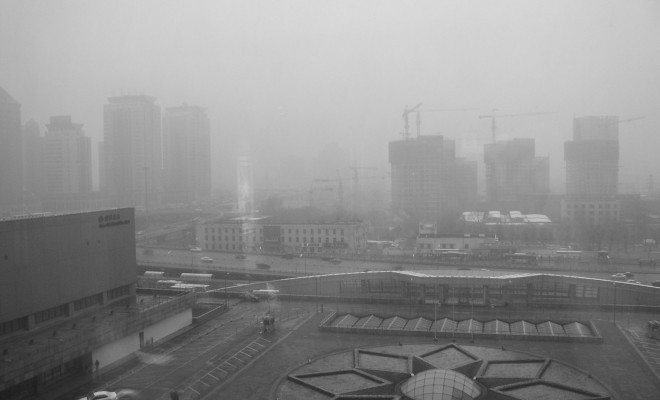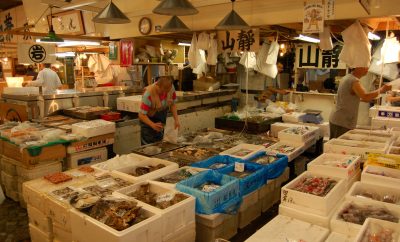 Image courtesy of [Kevin Dooley via Flickr]
Image courtesy of [Kevin Dooley via Flickr]
Energy & Environment
Red Alert in Beijing: Smog’s Debilitating Impacts
Beijing currently resembles a scene that could be from an apocalyptic horror movie: sidewalks deserted, citizens wearing masks, and an impenetrable layer of gray smoke flowing through street corners. Beijing recently announced its first “red alert” for smog, which led to the closure of schools and construction sites and a restriction on the number of cars on the road.
Since Beijing issued its red alert, Shanghai has issued a “yellow alert” and has taken to curbing factory work and suspending outdoor activities at schools. Elderly, young, and sick citizens are asked to stay indoors while the smog alert is in effect–but smog can take days or weeks to clear, leaving these residents essentially trapped in their homes. China’s smog problem has been growing for years but it is reaching a critical level wherein smog actually interferes with the daily behaviors of Chinese citizens. Read on for a look at how the smog problem developed and what the red alert signifies for the future.
The Meaning of the Red Alert
Although the Chinese government never instituted the red alert before this year, Beijing has had higher levels of pollution in the past. Beijing has reached the next-highest level, orange alert, several times but always stopped there. It has been speculated that the government decided to issue the red alert as a nod to public sentiment regarding the smog problem. According to the South China Morning Post,
A red alert marked official acknowledgment of the public perception that previous bouts of bad air had been played down. Some state media tried to put a positive spin on the development, with China Daily editorialising that ‘with the first such red alert, the capital has set a good example in this respect.’ But others took a darker view. China.com.cn, a news portal run by the State Council Information Office, said smog had damaged the government’s image, and Xinhua contrasted photographs of the city on pollution-free days and the depths of the alert.
Smog interferes with the image of a modern, progressive China. Pollution impacts not only the environment and the healthcare of the Chinese population, it also leads to a decline in economic growth. Smog limits the number of days workers can leave their homes and causes health problems for those who do work in urban centers. Toxic air means that life expectancy is an estimated five years shorter for a person living in Northern China than a person living in Southern China. In addition, China’s brain drain–a phenomenon where educated professionals emigrate to other nations rather than working in their country of origin–has been largely linked to pollution. Educated young workers want to start families in countries where the air is better. Chinese youth have an altogether different concept of outdoors than their parents do. In an interview with the New York Times, a cafe manager named Kan Tingting said that
What bothers me the most is that my child may have a very negative view of nature. She loves nature much less than she would in a normal environment. I don’t want her to grow up thinking nature is ugly.
In a country where “smog days” are akin to snow days in the United States, many children are growing up thinking of smog as a part of their daily life rather than an environmental hazard.
Smog in the Cities
China’s air pollution comes largely from the use of coal in its major industrial cities. China’s economic boom has generated massive economic growth, but that led to a parallel spike in airborne pollutants. Coal pollution is compounded with car emissions to create a toxic atmosphere, only exacerbated by dust storms and construction dust that floats in the air of most urban centers. Beijing recognized the sources of its pollution and has striven to use coal substitutes and limit the use of cars, but those solutions have yet to create lasting change in the smog levels.
Yang Weimin, Deputy Chair of the Central Leading Group on Finance and Economic Affairs, stated earlier this week that China will need to build ten new mega-cities to offset the pollution and traffic pressures of Beijing. Mainland China has six mega-cities (Beijing, Shanghai, Shenzhen, Guangzhou, Tianjin and Chongqing) and the Chinese government has recognized the need for shifting growth to other areas of the country. However, building these cities is a twofold challenge. First, it will be difficult to convince people to relocate to new cities without stable job prospects so the government will need to convince major companies to set up headquarters in this new set of mega-cities, but at the same time, they will need to retain the job sector in the existing cities. Second, building new cities requires a great deal of construction, which creates hazardous dust and only contributes to negative air quality in the short term.
Cleaning Up Before 2022
China will host the Winter Olympic Games in 2022 and officials have already stated that they plan to welcome athletes from around the world to a city with healthy air. The Beijing Olympics of 2008 were an unforgettable marvel that China hopes to match with the Winter Games, but air pollution has made athletes and coaches worry about the safety of competing there. When China made its bid for the 2008 Games, it promised to cut down on pollution in Beijing, and was largely successful in meeting its goal–during the Olympics, Beijing air quality was the best it had been in a decade. Beijing is clearly capable of reducing smog in the short-term, but the return of smog in the wake of the 2008 Games has left many pessimistic about the probability of long-term smog reduction. Although organizers of the Olympics have stated that they are treating the smog as a serious threat and plan to mitigate before athletes arrive, they have not outlined a precise plan for what they will do to reduce smog.
Profiting off of China’s Plight
This week, a Canadian company made headlines for charging up to $28 for bottles of “clean air” on the Chinese market. Vitality Air, which bottles air from Banff and Lake Louise, has seen a massive spike in sales in China over the past two months. Vitality Air began almost as a joke–co-founder Moses Lam listed a Ziploc bag of air on Ebay to see how much he could get from it, and then ran with the idea of “selling air”. Vitality Air prides itself on being hand-bottled and is supposed to be used to fight hangovers, lethargy and now, pollution. Bottled air may seem to be a ridiculous concept but according to the Times of India:
Vitality Air is not the only business cashing in on China’s pollution problem – a restaurant in in Zhangjiagang city recently started charging patrons for fresh air, after owners bought air filtration machines for the establishment and added a surcharge to people’s bills for the operation costs.
Selling air like it is any other commodity may be a fad sparked by the introduction of the red alert, but it raises interesting questions about the future of commodities in China. What products are Chinese citizens willing to buy in order to feel safe, and does that make them a target for companies that seek to profit off of their distress? Will foreign countries take advantage of China’s environmental weaknesses to sell them unexpected products or will they commit valuable technology to solving the pollution problem?
Conclusion
As the world celebrates the major climate agreement made in Paris this week, managing pollution and reducing smog seems like a more manageable task. Yet in China, the damage may be irreversible and a new generation may grow up without access to clean air. It is tempting to accept China’s air pollution as a problem too monolithic to tackle but considering the impressive reduction in smog that the country enacted before the Olympics of 2008, mitigating smog is possible. It will require political action and firm commitments to reach the government’s goal of reducing smog by 2022. China’s leading officials need to seek immediate, effective changes before the red alert becomes a commonplace event in Beijing.
Resources
CNN: Smog in China Closes Schools and Construction Sites, Cuts Traffic in Beijing
The Guardian: Smog Envelops Beijing: Before and After Pictures as City Goes on Red Alert
New York Times: Smog So Thick, Beijing Comes to a Standstill
USA Today: Punchlines: China’s Smog Days Beat Snow Days
ABC News: Hazardous Smog Blankets Shanghai, China Pledges to Clean up by 2022 Winter Olympics
Times of India: Canadian Company Sells Bottled Fresh Mountain Air in China as Smog Levels Worsen
CNN: Canadian Start-up Sells Bottled Air to China, Says Sales Booming








Comments